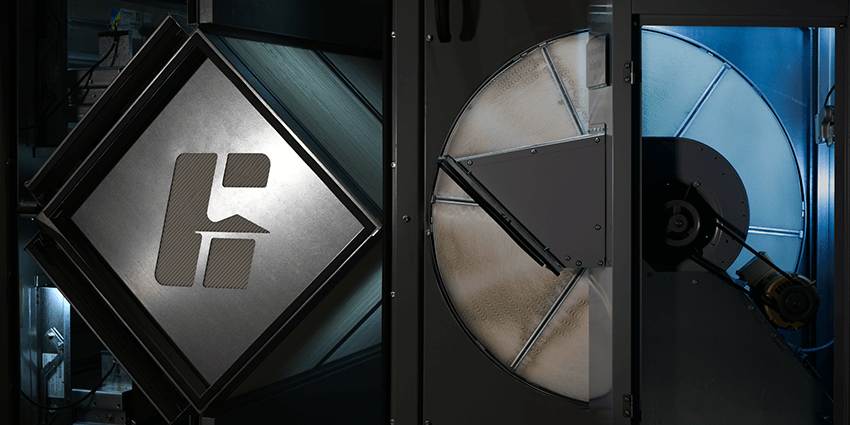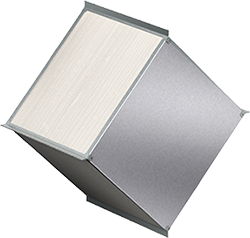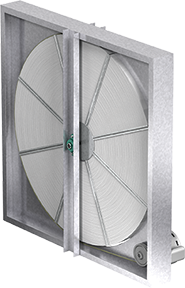Apply energy recovery to ventilation systems -- It's the Law!

Differences in Energy Recovery Devices
Understanding the differences between each device is key to making an educated decision on the best product for an application.
Consider unit construction that houses the energy recovery device. Is the housing single or double-walled? Can you access internal components for ease of maintenance through bolt on or hinged access doors? Are the fans direct drive or belt-driven? These features often differentiate an economy version and a high-end product. However, what really matters is the construction type, performance, and serviceability of the energy recovery device.
 |
| Figure 1 - Fiber membrane energy core |
Energy cores are cube-like, static devices that come in different materials. Fiber membrane cores (Figure 1) are manufactured using a paper-like composite, sometimes referred to as a resin. This resin transfers heat and moisture directly through the material. Polymer membrane cores (Figure 2) are manufactured from corrugated aluminum sheets with layers of a plastic polymer substrate offering a more substantial design. The aluminum transfers the heat while the polymer substrate transfers the moisture. Although both are similar in shape and size, maintenance and performance are different.
 |
| Figure 2 - Polymer membrane energy core |
Energy cores require necessary maintenance to ensure proper airflow (airflow affects the performance of an ERV). Fiber cores can be surface cleaned using a vacuum, allowing for quick maintenance and less labor. Polymer cores are washable and offer a more in-depth clean. Both require the necessary and routine maintenance to ensure proper airflow. Remember, airflow affects the performance of the ERV. Fiber cores have a peak ERR of 60% while polymer cores peak at 65%. Due to the physical construction of the polymer core, you can expect up to 15% more airflow capacity due to the physical construction of the polymer core than the same size fiber core.
 |
| Figure 3 - Energy wheel |
Another option to consider is the ERV with a polymer energy wheel (figure 3) that offers a lightweight design, thin profile, and segmented wheel construction. The energy wheel is the most effective product of available energy recovery devices, with an impressive ERR up to 80%. Polymer wheels rotate through exhaust and supply airstream using a motor/pulley system. These wheels are manufactured using a polymer wrap, impregnated with a desiccant that transfers both heat and moisture. The polymer wheel ERV has reliable components that have been proven over many decades of practical application. The polymer energy wheels, like polymer energy cores, also are washable, for thorough cleaning.
Comparing Core Devices to the Energy Wheel
Use of an energy core or the energy wheel depends on the application. Applications requiring 2,500 cfm or less tend to match the capabilities of an energy core, regardless whether the membrane is a fiber or polymer material. ERV units with an energy core have a smaller footprint for these applications. The unit size increases to house additional cores as CFM demands increase. For roughly every 1,000 cfm, one energy core is required. As air volumes increase, the cores are positioned either side by side or stacked, resulting in either a long or tall unit. The energy wheel may make more sense as CFM demands increase as one energy wheel of a larger diameter can handle higher volumes of air without a significant increase in unit size.
The energy core has no moving parts. It is possible that some will interpret this to imply little or no maintenance. This is not true. The core still requires regular cleaning to maintain expected performance. In contrast, an energy wheel does have a motor, belt and pulley system. These components, however, have proven to be extremely reliable.
Both energy core and wheel units have small amounts of air leakage between the supply and exhaust airstreams. This cross leakage or exhaust air transfer ratio (EATR) is the percentage of air that is transferred from the return air stream back into the supply. Energy wheels have an EATR ranging from three to five percent. The EATR for energy cores range is up to one percent. Both energy recovery device types provide acceptable levels of leakage for most applications. Knowing the acceptable or allowable cross-leakage percentage for an energy recovery device in an application is important.
ASHRAE Standard 62.1 (Ventilation for Acceptable Indoor Air Quality) provides helpful guidance by identifying applications and their maximum ERV cross leakage. This Standard classifies air into four different categories:
- Class 1 air is clean air that is non-offensive, such as in an office space. This classification of air allows up to 100 percent recirculation.
- Class 2 air is non-harmful but mildly offensive, such as air from restroom exhaust. ASHRAE 62.1 only allows up to 10% of this air to be recirculated.
- Class 3 air is has significant contaminants and could possibly be hazardous. This type of air could be in places such as a vet office. Recirculating up to five percent of this air is allowable.
- Class 4 air is hazardous and typically found in applications such as lab exhaust.
Energy wheels and cores both meet the cross leakage criteria for Class 1, 2, and 3 air applications. Hazardous environments with Class 4 air cannot use energy core or wheel devices since the air could contain chemicals or gases harmful to humans. Other energy saving devices are required for this application.
It’s the Law—Choose Wisely
Understanding the requirements established in ASHRAE 90.1 is the first step. Local and State codes that adopt ASHRAE 90.1 make it a law to apply energy recovery devices in certain ventilation applications. Choosing between three different energy recovery devices can be challenging. Weigh the pros and cons of construction, performance, and maintenance to make the right decision. For more information on energy recovery application and options, please visit this link.
Energy Recovery

from